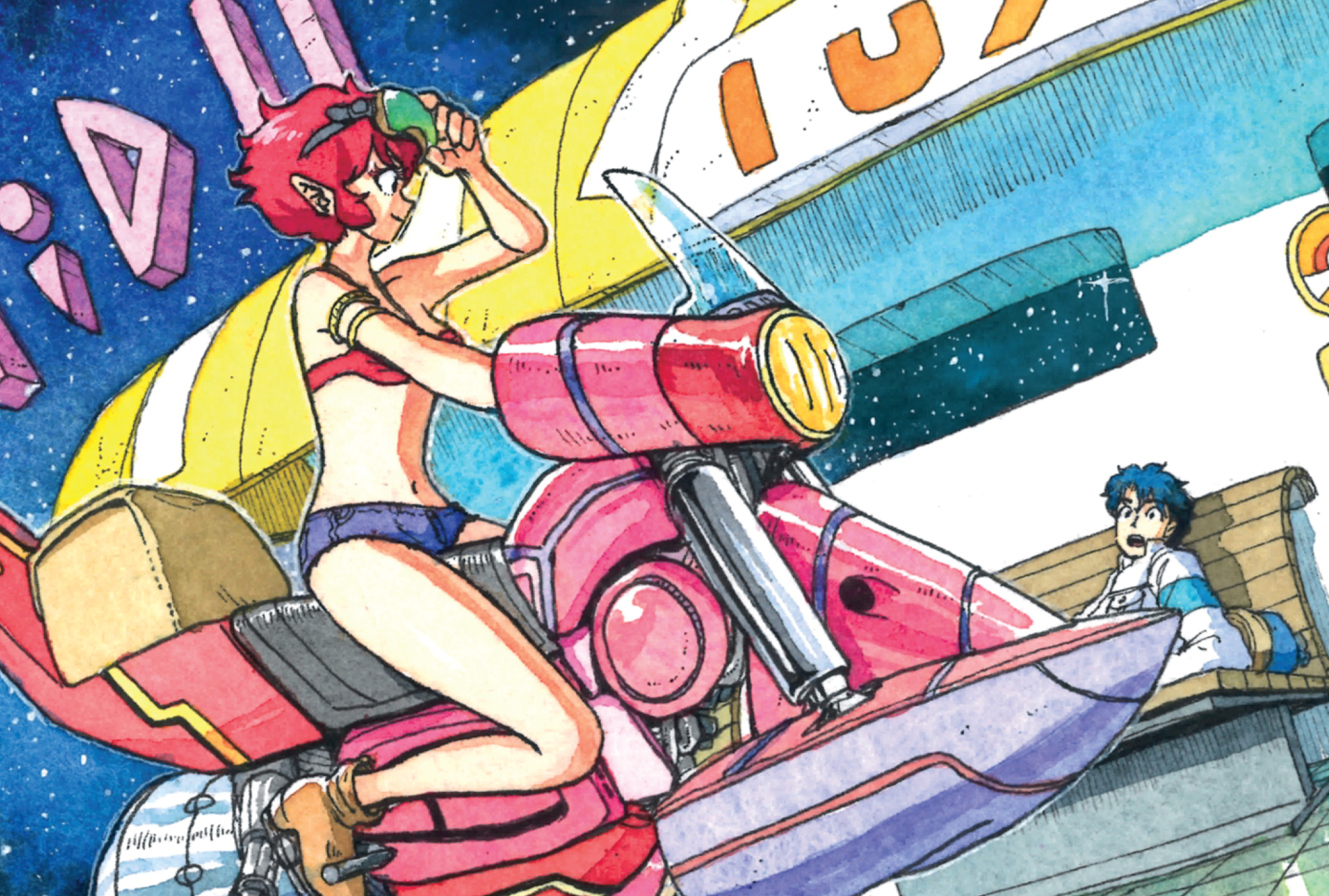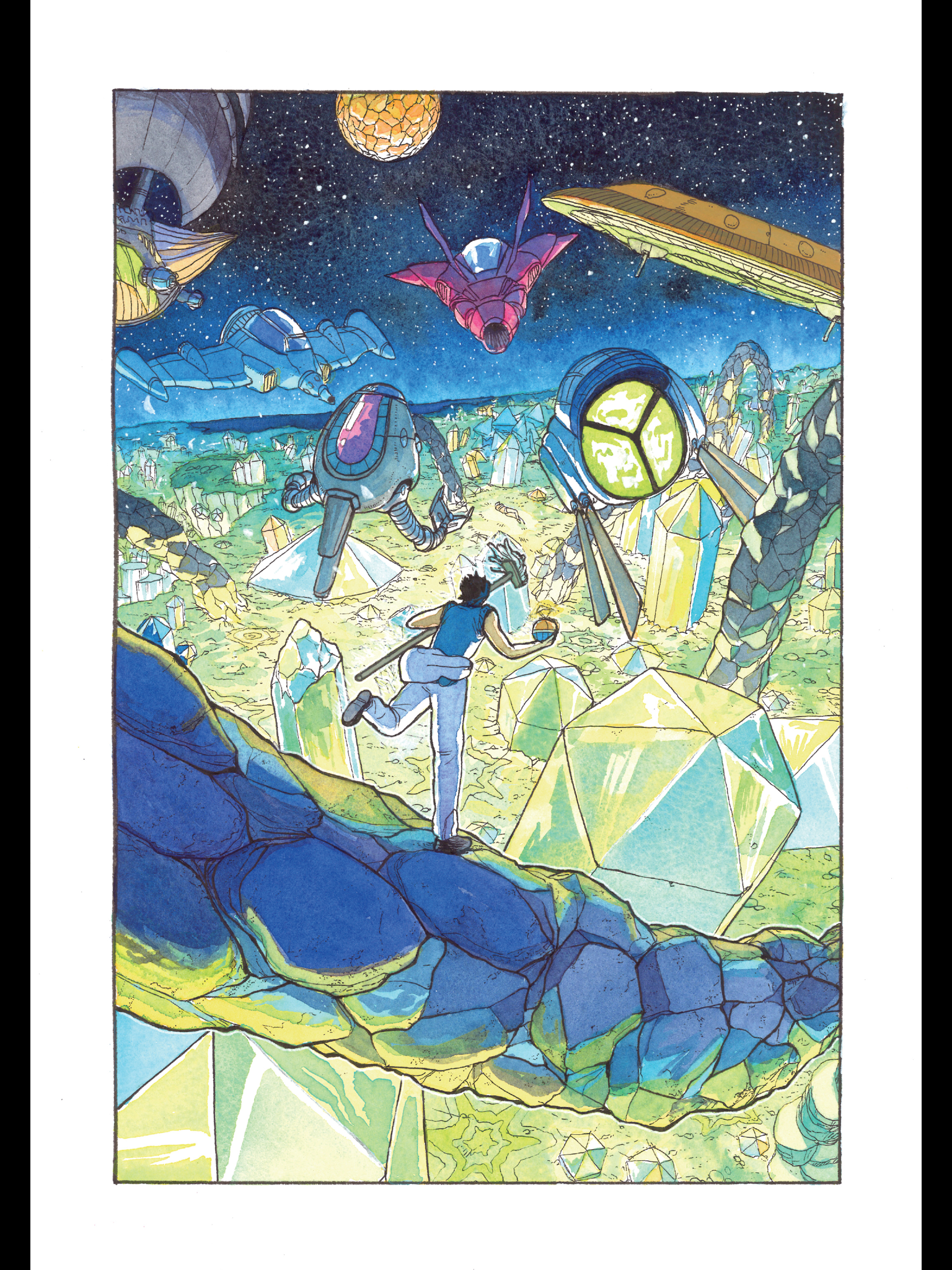Your Cart is Empty
Artists

"Sazan & Comet Girl": A Retro Adventure
September 15, 2020 4 min read 0 Comments

Nostalgia is a powerful force and it can even hold sway on us with stories we’ve never seen before. YouTube is currently replete with compilations of 1980s Japanese City Pop set to clips of Urusei Yatsura and City Hunter to the delight of people that weren’t even zygotes when this stuff was out. But the easy breezy melodies combined with the intoxicating intermingling of neons and pastels captivates people and wraps them in a warm blanket of alto saxes. Sazan & Comet Girlby Yuriko Akase and published by Seven Seas Entertainment, goes for this same sort of pseudo-nostalgia, but in comic form.
Set in a far flung future, Sazan is a strapping young himbo from Earth who’s earnest and resourceful in his job of crafting miniature home planets for aliens. He hears the legend of the Comet Girl, a wandering woman on a flying motorbike that is endlessly hounded by villains and brigands since she also just happens to be a nigh limitless source of energy. But instead of a destructive force, Sazan happens upon Comet Girl, who’s name is Mina, and is a bubbly but fierce bounty hunter. Now Sazan and Mina flirt with each other while also flirting with danger as they’re chased by space pirates and intergalactic robots, but as Mina reflects on her life of constantly being on the run, she becomes increasingly afraid that she’s endangering Sazan, who wants nothing more than to be closer to Mina.

Reading Sazan & Comet Girl feels like watching an OVA from the 80s that was never released. On a narrative level it’s really not trying to reinvent the wheel, but the characters are cute and charming enough that you don’t mind. Where Sazan & Comet Girl really shines is its spectacular visuals. Mina the Comet Girl takes visual cues from bikini heroines of yesteryear such as Kei from Dirty Pair and Yohko from Leda: The Fantastic Adventure of Yohko, but with the sort of color pallet that feels more like it’s tapping into nostalgia for how 1980s manga looked rather than the actuality. Meanwhile the sprawling machines and spaceships seem torn from the works of Yoshinori Kanada. And yet, this manga never feels like it's directly cribbing from these sources so much as being cut from the same cloth. It's one thing to just imitate anime from the 1980s, Sazan feels like an actual product of that time. Pretty far removed from anything resembling hard science fiction, this story has pills that let you breathe in space, pirate ships cruising by the stars, aliens that look like pigs. Akase still renders this world with a sense of scope and scale as characters happen upon giant aliens and planet sized spaceships.

The evocation of vintage anime has to be deliberate considering Akase’s short comic, 80s Video Trip, has a similar nostalgic bent, but in the framework of slice of life romance. The Comics Journal reading “sequential art” enthusiast in me feels like I’m doing Sazan a disservice by continuously comparing a manga to another rather than on its own terms, but I consider it a testament to Akase’s dynamic action scenes and set pieces.
Akase is something of a newcomer, with only three titles under her belt (Sazan, 80s Video Trip, and the currently running Nightmare Busters). Akase didn't grow up during the era she's evoking in Sazan, though she clearly has a keen eye for older works. I think Akase is probably aware of how her story feels like an anime adventure, as Sazan and Mina are followed by a flying drone that’s streaming their escapades for the whole universe to see and cheer the rag tag heroes on who are just as unaware that they’re being watched as is Astro Boy on my TV.

The watercolor art is something to behold (and if you get this digitally via Comixology, the download is just shy of 2 gigabytes but makes for some great tablet wallpaper). I wish there was footage of Akase drawing these pages because you can tell she really went all out with her environments. See Sazan race down a rock formation, on a planet teaming with crystalline formations as spaceships circle around him and fill a sky dotted with stars! Marvel at Mina as she eludes a humanoid pig the size of a skyscraper while piloting a futuristic flying motorcycle! The pages are very populated, but Akase keeps things from feeling cluttered, and there’s a good sense of center to the action. The use of blues, purples, and reds feels particularly reminiscent of Yuzo Takada (3x3 Eyes, Cat Girl Nuku Nuku). The scope of this art feels really ambitious, especially when you consider that this was Akase’s first multi volume work (Sazan & Comet Girl was published as two volumes in Japan, but Seven Seas collects both volumes in a single omnibus) and clocks at about 500 pages. But even at that length, the story almost never slows down and constantly throws newer and bigger action scenes at you.
If you’re looking for a retro-style sci fi adventure manga replete with vibrant colors and spectacular scenery, Sazan & Comet Girl is currently available digitally and physically wherever manga is sold.
Subscribe
Sign up to get the latest on sales, new releases and more …
